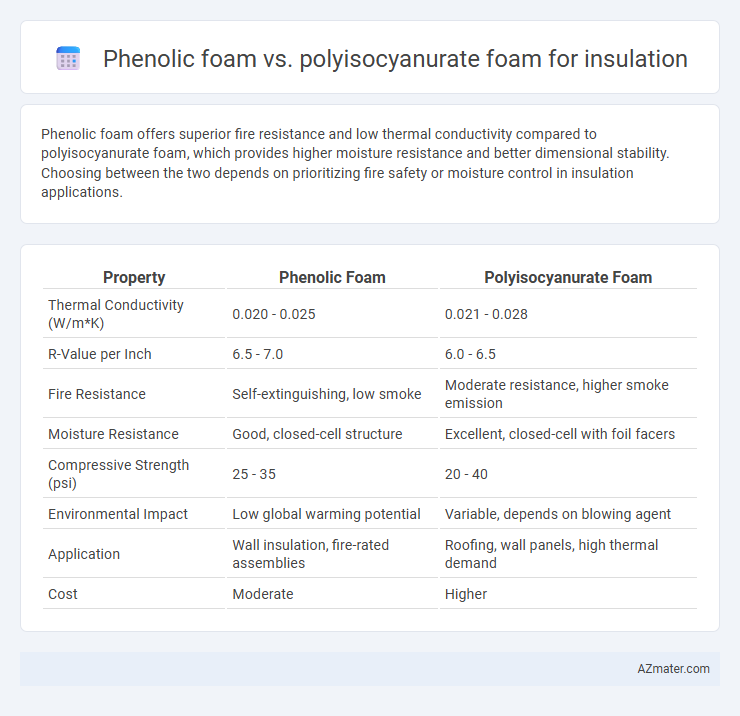Phenolic foam offers superior fire resistance and low thermal conductivity compared to polyisocyanurate foam, which provides higher moisture resistance and better dimensional stability. Choosing between the two depends on prioritizing fire safety or moisture control in insulation applications.
Table of Comparison
| Property | Phenolic Foam | Polyisocyanurate Foam |
|---|---|---|
| Thermal Conductivity (W/m*K) | 0.020 - 0.025 | 0.021 - 0.028 |
| R-Value per Inch | 6.5 - 7.0 | 6.0 - 6.5 |
| Fire Resistance | Self-extinguishing, low smoke | Moderate resistance, higher smoke emission |
| Moisture Resistance | Good, closed-cell structure | Excellent, closed-cell with foil facers |
| Compressive Strength (psi) | 25 - 35 | 20 - 40 |
| Environmental Impact | Low global warming potential | Variable, depends on blowing agent |
| Application | Wall insulation, fire-rated assemblies | Roofing, wall panels, high thermal demand |
| Cost | Moderate | Higher |
Overview of Phenolic Foam and Polyisocyanurate Foam
Phenolic foam offers superior fire resistance and low smoke emissions with a closed-cell structure that provides excellent thermal insulation, typically achieving R-values around 4.0 to 4.5 per inch. Polyisocyanurate foam, commonly used in roofing and wall insulation, features a rigid, closed-cell composition with higher R-values ranging from 6.0 to 6.5 per inch, delivering greater thermal performance. Both materials exhibit moisture resistance and structural rigidity but differ significantly in thermal efficiency and fire retardancy, influencing their applications in commercial and residential buildings.
Chemical Composition and Manufacturing Process
Phenolic foam consists primarily of phenol-formaldehyde resin formed through a condensation reaction, resulting in a rigid, closed-cell structure with high thermal resistance and fire-retardant properties. Polyisocyanurate foam, derived from the reaction between polyols and methylene diphenyl diisocyanate (MDI), undergoes a trimerization process that enhances its thermal stability and mechanical strength compared to conventional polyurethane foams. The manufacturing process of phenolic foam involves controlled curing and foaming agents to achieve dimensional stability, while polyisocyanurate foam is produced using higher isocyanate indices and catalysts to promote the formation of isocyanurate rings, influencing its durability and insulation performance.
Thermal Insulation Performance Comparison
Phenolic foam offers superior thermal insulation with a typical R-value of 4.5 to 5.0 per inch, outperforming polyisocyanurate foam, which generally provides an R-value of 5.0 to 6.5 per inch under optimal conditions but may degrade faster over time due to thermal drift. Phenolic foam's closed-cell structure ensures lower thermal conductivity and enhanced long-term stability, making it more reliable in maintaining insulation efficiency. Polyisocyanurate foam tends to have higher initial R-values but can experience performance loss in high humidity, whereas phenolic foam maintains consistent thermal resistance across varying environmental conditions.
Fire Resistance and Smoke Emissions
Phenolic foam offers superior fire resistance with a high limiting oxygen index (LOI) around 28-30%, producing low smoke emissions due to its char-forming nature. Polyisocyanurate foam also provides good fire resistance, typically with an LOI of 22-26%, but generates higher smoke and toxic gases during combustion. Choosing phenolic foam enhances fire safety in insulation applications by minimizing smoke release and improving structural integrity under fire conditions.
Moisture Resistance and Water Absorption
Phenolic foam exhibits superior moisture resistance with a closed-cell structure that significantly limits water absorption, making it highly effective for insulation in damp environments. Polyisocyanurate foam also offers good moisture resistance but tends to absorb slightly more water over time due to its cell structure. Choosing phenolic foam minimizes the risk of insulation degradation from moisture, ensuring prolonged thermal performance and durability.
Mechanical Strength and Durability
Phenolic foam offers superior mechanical strength with high compressive resistance, making it well-suited for load-bearing insulation applications. Polyisocyanurate foam provides excellent dimensional stability and long-term durability under thermal cycling, maintaining its insulating properties over extended periods. Both foams resist moisture absorption, but phenolic foam's closed-cell structure enhances its durability against physical and environmental stresses.
Environmental Impact and Sustainability
Phenolic foam offers low global warming potential (GWP) and excellent thermal performance, contributing to reduced energy consumption and lower carbon footprints in building insulation. Polyisocyanurate foam, while also providing high thermal resistance, often contains blowing agents with higher GWP and may be less sustainable due to fossil fuel-based components. Phenolic foam's inherent fire resistance and potential for eco-friendly production enhance its sustainability profile compared to polyisocyanurate foam.
Installation Practices and Ease of Use
Phenolic foam offers superior fire resistance and dimensional stability, making it easier to handle during installation without the need for protective coatings. Polyisocyanurate foam provides higher R-values per inch, but its rigid structure requires precise cutting and fitting, increasing labor time. Both materials demand careful sealing to prevent thermal bridging, yet phenolic foam's lightweight nature enhances ease of use on uneven surfaces.
Cost Analysis and Economic Considerations
Phenolic foam offers lower initial costs compared to polyisocyanurate foam, making it a cost-effective choice for budget-sensitive insulation projects. Polyisocyanurate foam provides superior thermal resistance and longer lifespan, potentially reducing long-term energy expenses and maintenance costs despite its higher upfront price. Economic considerations should weigh phenolic foam's affordability against polyisocyanurate's efficiency and durability to determine the best return on investment for specific insulation needs.
Application Suitability in Construction
Phenolic foam offers excellent fire resistance and low smoke emissions, making it ideal for commercial buildings requiring stringent fire safety standards. Polyisocyanurate foam provides higher R-values per inch and superior moisture resistance, which suits residential roofing and wall insulation in humid climates. Choosing between these foams depends on balancing insulation efficiency, fire safety codes, and environmental exposure specific to the construction project.

Infographic: Phenolic foam vs Polyisocyanurate foam for Insulation
 azmater.com
azmater.com